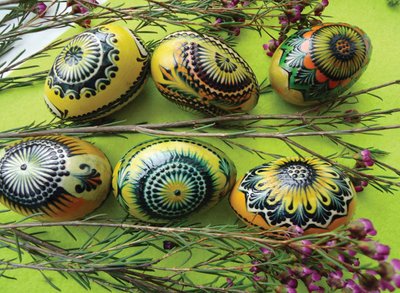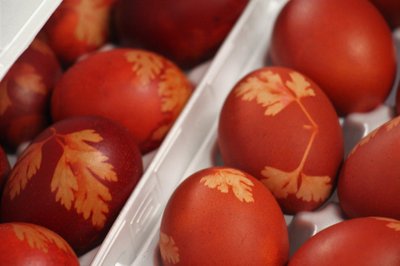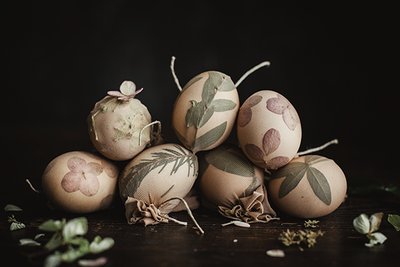This, the most important symbol of Easter, has been with us since the times of paganism – our ancestors associated it with resurrection and life. Decorated with the first herbs of spring, immersed in a bath of onion husks, oak or alder bark, or summer greens, or ornately decorated with wax, these eggs are the centrepiece of the Easter table, both now and then.
Did you know that the shape of an egg symbolizes cosmos, fertility and the circle of life? Lithuanians believed that for centuries, even back in pagan times. So there’s no surprise that traditions of egg marbling are rooted deep in Lithuanian culture. Bring those traditions to your home with these nifty DIY crafts that’ll make unexpected colors to your Easter table, Lithuania Travel invites.
Wax-and-dye Easter eggs
1. First, boil the eggs.
2. Then, prepare the tools. You can use a tealight candle, an essential oil burner or a homemade burner to melt the wax. You’ll also need a styling tool that you can make at home using a pencil and a ball pin (stick a ball pin into the pencil core, and you are good to go), and some beeswax.
Melt the beeswax in an oil burner.
3. Take a styling tool and dip its tip into the wax. Then form an ornament of dashes and dots on the egg. Make sure you do it fast because the wax cools very quickly.
4. After you’ve completed the ornament, submerge the egg into the dye. Remember – the dye shouldn’t be hot. Otherwise, the wax will come off.
5. After the egg is colored, remove the wax. You can either scrape it off or heat it over a candle and wipe the warm wax off with a napkin.

Etched Easter eggs
1. Boil the eggs in a natural or synthetic dye.
2. Let the eggs cool.
3. Take a paper-knife or another sharp tool and etch the egg the way you like it. Traditionally, Lithuanian techniques involve geometric and floral etchings.

Easter eggs dyed with onion skins
1. See if you have all you need: a bowl of cold water, some onion skins, some cloth, and a thread.
2. Soak the onion skins in water and get the eggshells wet. Place onion skins around the egg. Leave some empty spots – the dye you’ll boil the eggs in will color them.
3. Wrap the egg in a cloth and tie it with a thread.
4. Boil the eggs in a natural or synthetic dye. After that, unwrap them, and you’re done!

Easter eggs dyed with herbs or grain
1. Gather all the necessary things together: a bowl of cold water, some herbs, flower blossoms and whatever else you can find outside, some string and a handful of grain, also, some cloth, and a thread.
2. Soak the herbs, the string and the grain in water and get the surface of the eggshell wet. Place whatever you like around the egg – you may mix it up or use the materials separately.
3.Wrap the egg in cloth and tie it with the thread.
4.Boil the eggs in a natural or synthetic dye. After the eggs are boiled, wrap them out of the fabric and enjoy!

Naturally marbled Easter eggs
For blue, cut or grate a small head of red cabbage. The finer you grate it, the more pigment it’ll release. Put the chopped cabbage in a pot and pour enough water to dip the desired number of eggs in it. Add 2-3 tablespoons of vinegar. Boil the dye and let it simmer for about 15 minutes. Allow to cool slightly and dip the boiled eggs in it or cook the eggs together for an even brighter color. Leave the eggs in the dye overnight.
If you want your eggs red, finely grate 4 beets, pour enough water to sink the eggs and add 2 tablespoons of vinegar. Dip the boiled eggs into the dye and leave overnight or longer.
For yellow, pour a packet of turmeric powder into the water and add 1 tablespoon of vinegar. Boil the eggs with the dye and leave to soak overnight or let the mixture boil for about 15 minutes and then dip the warm, pre-boiled eggs in it and leave overnight.
If you want to bring out the color brown, mix the skins of at least 8 red onions with water. Add 1-2 tablespoons of vinegar. You can also boil the eggs in the mixture and leave them overnight or boil the mixture for 15 minutes and soak the pre-boiled eggs in it for a few hours. The longer the eggs stay in the dye, the darker the color.
For orange, repeat the instructions above, but use yellow onion skins instead.
